Comprehensive Analysis of McDonald's Strategic and Ethical Practices
VerifiedAdded on 2020/05/28
|16
|3245
|91
AI Summary
The report delves into various aspects of management crucial to understanding the operational dynamics at McDonald’s in Singapore. Initially, it explores managerial approaches and functions essential for effective leadership within the organization. The significance of macro-environmental analysis is underscored as a means to maintain competitiveness and adaptability in the fast-food industry. Strategic management tools such as SWOT, PESTLE, and Porter's Five Forces are employed specifically on McDonald’s to highlight strengths, weaknesses, opportunities, threats, political/economic/social/technological/legal factors, and competitive forces affecting its business strategy. Ethical issues inherent in business operations are discussed through the lens of four ethical decision-making rules and corporate social responsibility initiatives that contribute positively to society. The final section emphasizes the importance of organizational culture, exploring reasons behind resistance to cultural change and how such culture influences decision-making and communication within McDonald's. This comprehensive report provides insights into management practices, strategic planning, ethical considerations, and cultural aspects pivotal for successful operations at McDonald’s in Singapore.
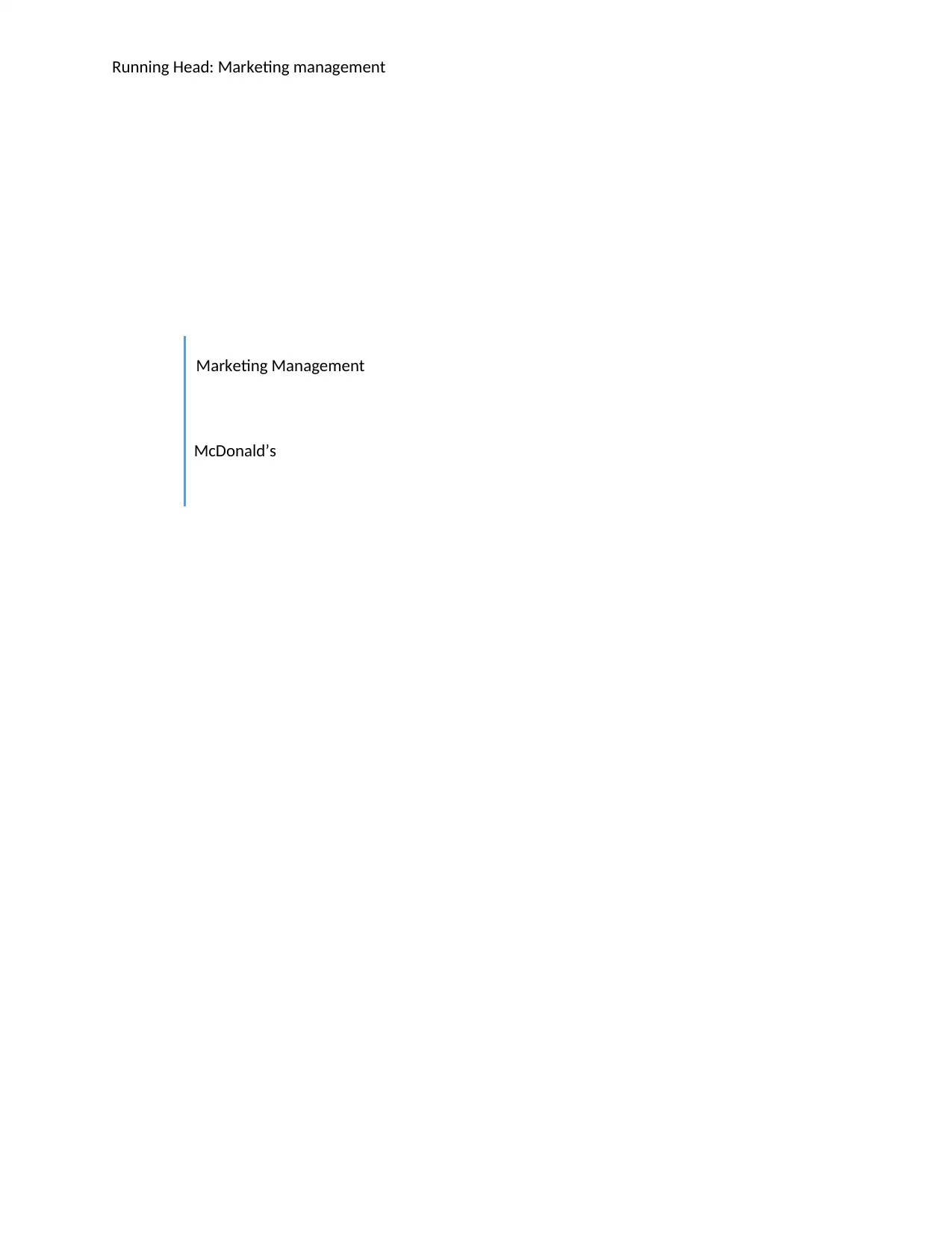
Running Head: Marketing management
Marketing Management
McDonald’s
Marketing Management
McDonald’s
Paraphrase This Document
Need a fresh take? Get an instant paraphrase of this document with our AI Paraphraser
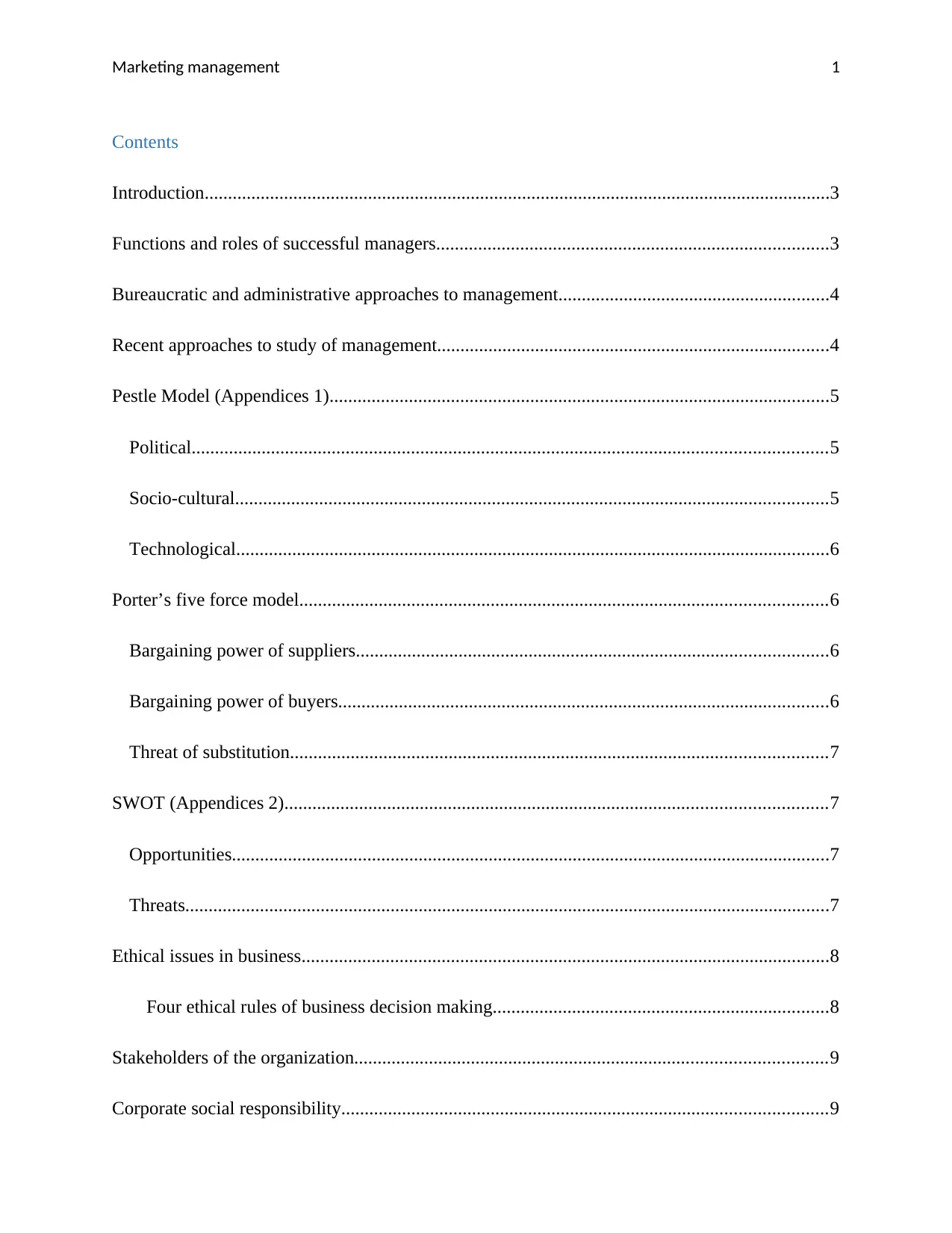
Marketing management 1
Contents
Introduction......................................................................................................................................3
Functions and roles of successful managers....................................................................................3
Bureaucratic and administrative approaches to management..........................................................4
Recent approaches to study of management....................................................................................4
Pestle Model (Appendices 1)...........................................................................................................5
Political........................................................................................................................................5
Socio-cultural...............................................................................................................................5
Technological...............................................................................................................................6
Porter’s five force model.................................................................................................................6
Bargaining power of suppliers.....................................................................................................6
Bargaining power of buyers.........................................................................................................6
Threat of substitution...................................................................................................................7
SWOT (Appendices 2)....................................................................................................................7
Opportunities................................................................................................................................7
Threats..........................................................................................................................................7
Ethical issues in business.................................................................................................................8
Four ethical rules of business decision making........................................................................8
Stakeholders of the organization.....................................................................................................9
Corporate social responsibility........................................................................................................9
Contents
Introduction......................................................................................................................................3
Functions and roles of successful managers....................................................................................3
Bureaucratic and administrative approaches to management..........................................................4
Recent approaches to study of management....................................................................................4
Pestle Model (Appendices 1)...........................................................................................................5
Political........................................................................................................................................5
Socio-cultural...............................................................................................................................5
Technological...............................................................................................................................6
Porter’s five force model.................................................................................................................6
Bargaining power of suppliers.....................................................................................................6
Bargaining power of buyers.........................................................................................................6
Threat of substitution...................................................................................................................7
SWOT (Appendices 2)....................................................................................................................7
Opportunities................................................................................................................................7
Threats..........................................................................................................................................7
Ethical issues in business.................................................................................................................8
Four ethical rules of business decision making........................................................................8
Stakeholders of the organization.....................................................................................................9
Corporate social responsibility........................................................................................................9
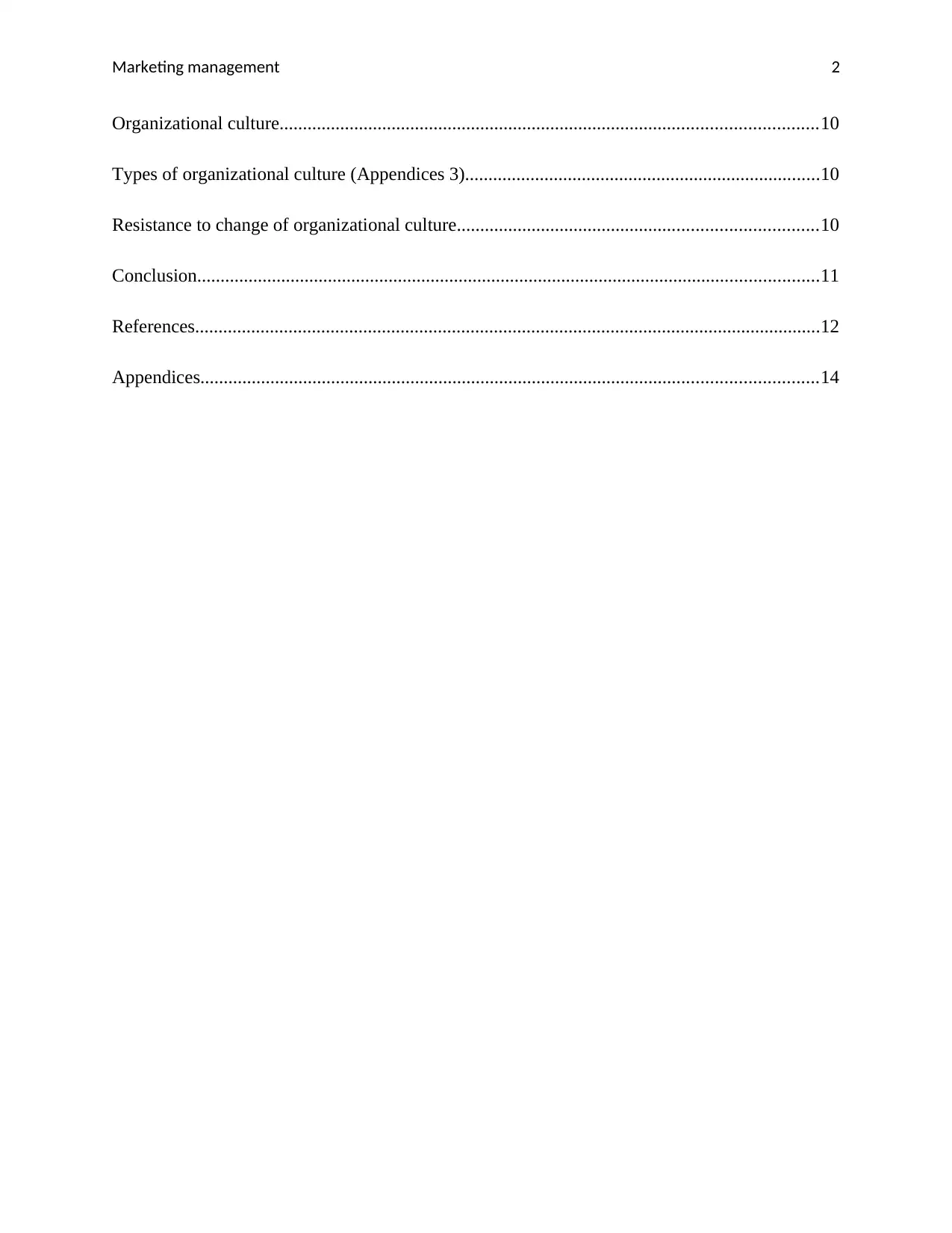
Marketing management 2
Organizational culture...................................................................................................................10
Types of organizational culture (Appendices 3)............................................................................10
Resistance to change of organizational culture.............................................................................10
Conclusion.....................................................................................................................................11
References......................................................................................................................................12
Appendices....................................................................................................................................14
Organizational culture...................................................................................................................10
Types of organizational culture (Appendices 3)............................................................................10
Resistance to change of organizational culture.............................................................................10
Conclusion.....................................................................................................................................11
References......................................................................................................................................12
Appendices....................................................................................................................................14
⊘ This is a preview!⊘
Do you want full access?
Subscribe today to unlock all pages.

Trusted by 1+ million students worldwide
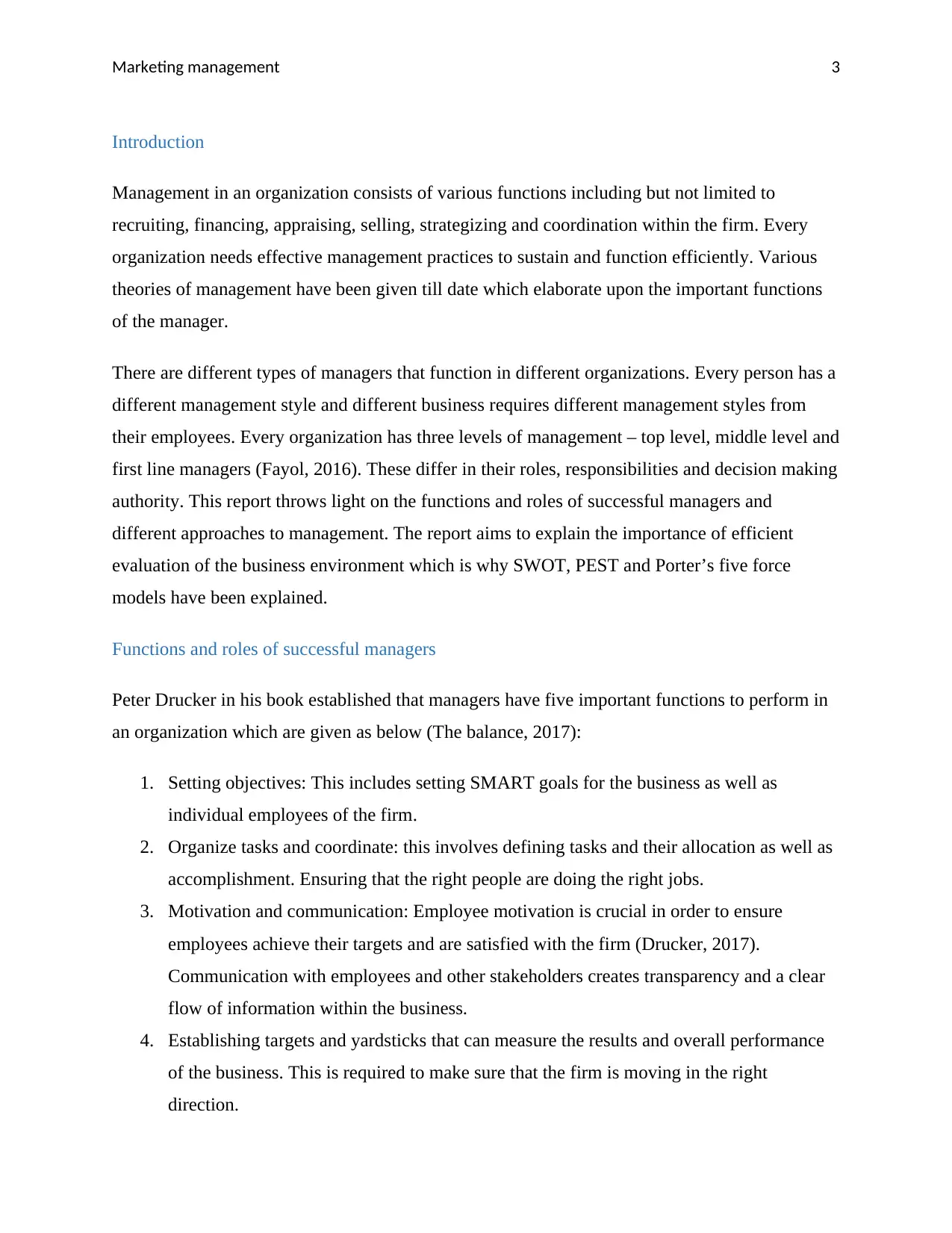
Marketing management 3
Introduction
Management in an organization consists of various functions including but not limited to
recruiting, financing, appraising, selling, strategizing and coordination within the firm. Every
organization needs effective management practices to sustain and function efficiently. Various
theories of management have been given till date which elaborate upon the important functions
of the manager.
There are different types of managers that function in different organizations. Every person has a
different management style and different business requires different management styles from
their employees. Every organization has three levels of management – top level, middle level and
first line managers (Fayol, 2016). These differ in their roles, responsibilities and decision making
authority. This report throws light on the functions and roles of successful managers and
different approaches to management. The report aims to explain the importance of efficient
evaluation of the business environment which is why SWOT, PEST and Porter’s five force
models have been explained.
Functions and roles of successful managers
Peter Drucker in his book established that managers have five important functions to perform in
an organization which are given as below (The balance, 2017):
1. Setting objectives: This includes setting SMART goals for the business as well as
individual employees of the firm.
2. Organize tasks and coordinate: this involves defining tasks and their allocation as well as
accomplishment. Ensuring that the right people are doing the right jobs.
3. Motivation and communication: Employee motivation is crucial in order to ensure
employees achieve their targets and are satisfied with the firm (Drucker, 2017).
Communication with employees and other stakeholders creates transparency and a clear
flow of information within the business.
4. Establishing targets and yardsticks that can measure the results and overall performance
of the business. This is required to make sure that the firm is moving in the right
direction.
Introduction
Management in an organization consists of various functions including but not limited to
recruiting, financing, appraising, selling, strategizing and coordination within the firm. Every
organization needs effective management practices to sustain and function efficiently. Various
theories of management have been given till date which elaborate upon the important functions
of the manager.
There are different types of managers that function in different organizations. Every person has a
different management style and different business requires different management styles from
their employees. Every organization has three levels of management – top level, middle level and
first line managers (Fayol, 2016). These differ in their roles, responsibilities and decision making
authority. This report throws light on the functions and roles of successful managers and
different approaches to management. The report aims to explain the importance of efficient
evaluation of the business environment which is why SWOT, PEST and Porter’s five force
models have been explained.
Functions and roles of successful managers
Peter Drucker in his book established that managers have five important functions to perform in
an organization which are given as below (The balance, 2017):
1. Setting objectives: This includes setting SMART goals for the business as well as
individual employees of the firm.
2. Organize tasks and coordinate: this involves defining tasks and their allocation as well as
accomplishment. Ensuring that the right people are doing the right jobs.
3. Motivation and communication: Employee motivation is crucial in order to ensure
employees achieve their targets and are satisfied with the firm (Drucker, 2017).
Communication with employees and other stakeholders creates transparency and a clear
flow of information within the business.
4. Establishing targets and yardsticks that can measure the results and overall performance
of the business. This is required to make sure that the firm is moving in the right
direction.
Paraphrase This Document
Need a fresh take? Get an instant paraphrase of this document with our AI Paraphraser
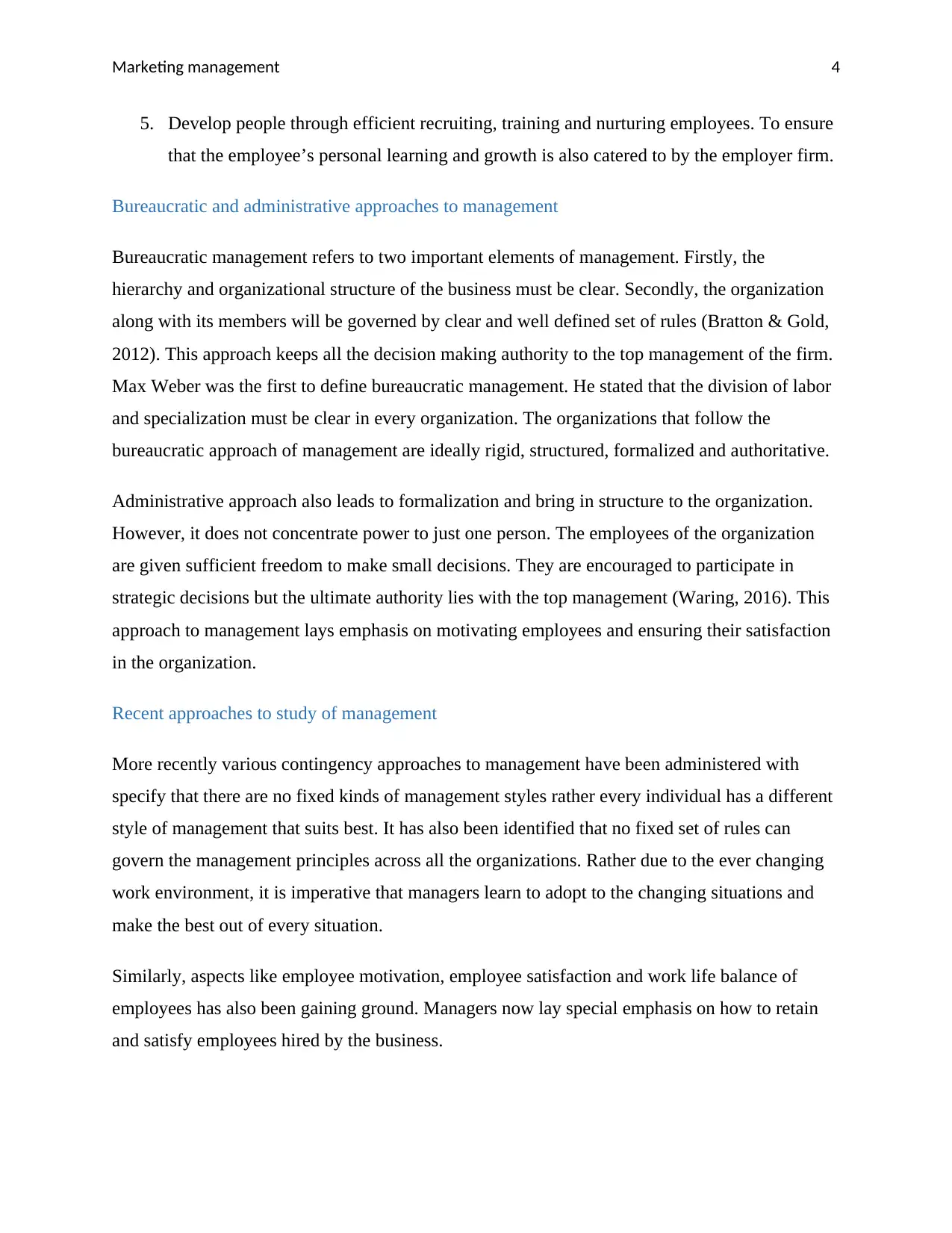
Marketing management 4
5. Develop people through efficient recruiting, training and nurturing employees. To ensure
that the employee’s personal learning and growth is also catered to by the employer firm.
Bureaucratic and administrative approaches to management
Bureaucratic management refers to two important elements of management. Firstly, the
hierarchy and organizational structure of the business must be clear. Secondly, the organization
along with its members will be governed by clear and well defined set of rules (Bratton & Gold,
2012). This approach keeps all the decision making authority to the top management of the firm.
Max Weber was the first to define bureaucratic management. He stated that the division of labor
and specialization must be clear in every organization. The organizations that follow the
bureaucratic approach of management are ideally rigid, structured, formalized and authoritative.
Administrative approach also leads to formalization and bring in structure to the organization.
However, it does not concentrate power to just one person. The employees of the organization
are given sufficient freedom to make small decisions. They are encouraged to participate in
strategic decisions but the ultimate authority lies with the top management (Waring, 2016). This
approach to management lays emphasis on motivating employees and ensuring their satisfaction
in the organization.
Recent approaches to study of management
More recently various contingency approaches to management have been administered with
specify that there are no fixed kinds of management styles rather every individual has a different
style of management that suits best. It has also been identified that no fixed set of rules can
govern the management principles across all the organizations. Rather due to the ever changing
work environment, it is imperative that managers learn to adopt to the changing situations and
make the best out of every situation.
Similarly, aspects like employee motivation, employee satisfaction and work life balance of
employees has also been gaining ground. Managers now lay special emphasis on how to retain
and satisfy employees hired by the business.
5. Develop people through efficient recruiting, training and nurturing employees. To ensure
that the employee’s personal learning and growth is also catered to by the employer firm.
Bureaucratic and administrative approaches to management
Bureaucratic management refers to two important elements of management. Firstly, the
hierarchy and organizational structure of the business must be clear. Secondly, the organization
along with its members will be governed by clear and well defined set of rules (Bratton & Gold,
2012). This approach keeps all the decision making authority to the top management of the firm.
Max Weber was the first to define bureaucratic management. He stated that the division of labor
and specialization must be clear in every organization. The organizations that follow the
bureaucratic approach of management are ideally rigid, structured, formalized and authoritative.
Administrative approach also leads to formalization and bring in structure to the organization.
However, it does not concentrate power to just one person. The employees of the organization
are given sufficient freedom to make small decisions. They are encouraged to participate in
strategic decisions but the ultimate authority lies with the top management (Waring, 2016). This
approach to management lays emphasis on motivating employees and ensuring their satisfaction
in the organization.
Recent approaches to study of management
More recently various contingency approaches to management have been administered with
specify that there are no fixed kinds of management styles rather every individual has a different
style of management that suits best. It has also been identified that no fixed set of rules can
govern the management principles across all the organizations. Rather due to the ever changing
work environment, it is imperative that managers learn to adopt to the changing situations and
make the best out of every situation.
Similarly, aspects like employee motivation, employee satisfaction and work life balance of
employees has also been gaining ground. Managers now lay special emphasis on how to retain
and satisfy employees hired by the business.
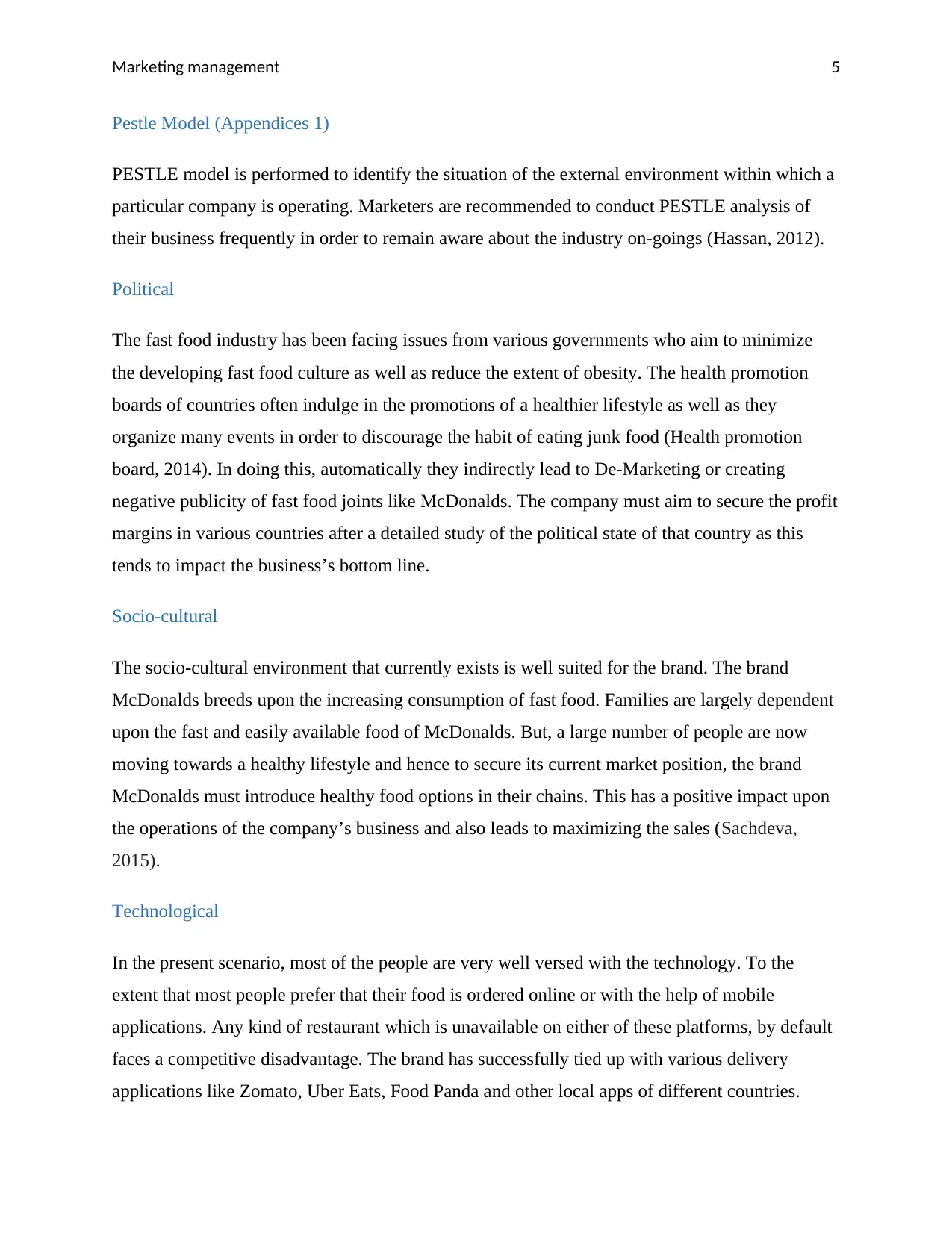
Marketing management 5
Pestle Model (Appendices 1)
PESTLE model is performed to identify the situation of the external environment within which a
particular company is operating. Marketers are recommended to conduct PESTLE analysis of
their business frequently in order to remain aware about the industry on-goings (Hassan, 2012).
Political
The fast food industry has been facing issues from various governments who aim to minimize
the developing fast food culture as well as reduce the extent of obesity. The health promotion
boards of countries often indulge in the promotions of a healthier lifestyle as well as they
organize many events in order to discourage the habit of eating junk food (Health promotion
board, 2014). In doing this, automatically they indirectly lead to De-Marketing or creating
negative publicity of fast food joints like McDonalds. The company must aim to secure the profit
margins in various countries after a detailed study of the political state of that country as this
tends to impact the business’s bottom line.
Socio-cultural
The socio-cultural environment that currently exists is well suited for the brand. The brand
McDonalds breeds upon the increasing consumption of fast food. Families are largely dependent
upon the fast and easily available food of McDonalds. But, a large number of people are now
moving towards a healthy lifestyle and hence to secure its current market position, the brand
McDonalds must introduce healthy food options in their chains. This has a positive impact upon
the operations of the company’s business and also leads to maximizing the sales (Sachdeva,
2015).
Technological
In the present scenario, most of the people are very well versed with the technology. To the
extent that most people prefer that their food is ordered online or with the help of mobile
applications. Any kind of restaurant which is unavailable on either of these platforms, by default
faces a competitive disadvantage. The brand has successfully tied up with various delivery
applications like Zomato, Uber Eats, Food Panda and other local apps of different countries.
Pestle Model (Appendices 1)
PESTLE model is performed to identify the situation of the external environment within which a
particular company is operating. Marketers are recommended to conduct PESTLE analysis of
their business frequently in order to remain aware about the industry on-goings (Hassan, 2012).
Political
The fast food industry has been facing issues from various governments who aim to minimize
the developing fast food culture as well as reduce the extent of obesity. The health promotion
boards of countries often indulge in the promotions of a healthier lifestyle as well as they
organize many events in order to discourage the habit of eating junk food (Health promotion
board, 2014). In doing this, automatically they indirectly lead to De-Marketing or creating
negative publicity of fast food joints like McDonalds. The company must aim to secure the profit
margins in various countries after a detailed study of the political state of that country as this
tends to impact the business’s bottom line.
Socio-cultural
The socio-cultural environment that currently exists is well suited for the brand. The brand
McDonalds breeds upon the increasing consumption of fast food. Families are largely dependent
upon the fast and easily available food of McDonalds. But, a large number of people are now
moving towards a healthy lifestyle and hence to secure its current market position, the brand
McDonalds must introduce healthy food options in their chains. This has a positive impact upon
the operations of the company’s business and also leads to maximizing the sales (Sachdeva,
2015).
Technological
In the present scenario, most of the people are very well versed with the technology. To the
extent that most people prefer that their food is ordered online or with the help of mobile
applications. Any kind of restaurant which is unavailable on either of these platforms, by default
faces a competitive disadvantage. The brand has successfully tied up with various delivery
applications like Zomato, Uber Eats, Food Panda and other local apps of different countries.
⊘ This is a preview!⊘
Do you want full access?
Subscribe today to unlock all pages.

Trusted by 1+ million students worldwide
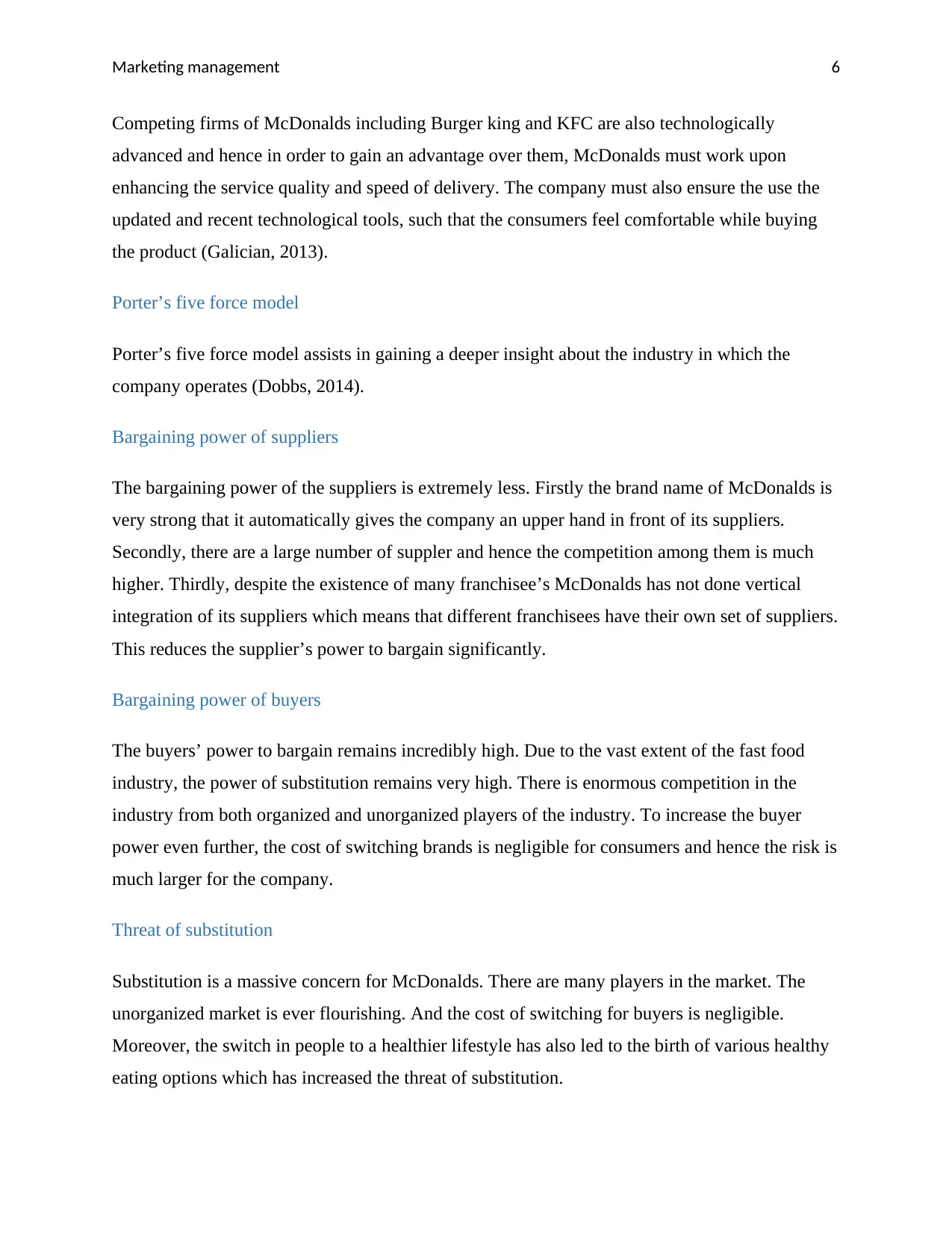
Marketing management 6
Competing firms of McDonalds including Burger king and KFC are also technologically
advanced and hence in order to gain an advantage over them, McDonalds must work upon
enhancing the service quality and speed of delivery. The company must also ensure the use the
updated and recent technological tools, such that the consumers feel comfortable while buying
the product (Galician, 2013).
Porter’s five force model
Porter’s five force model assists in gaining a deeper insight about the industry in which the
company operates (Dobbs, 2014).
Bargaining power of suppliers
The bargaining power of the suppliers is extremely less. Firstly the brand name of McDonalds is
very strong that it automatically gives the company an upper hand in front of its suppliers.
Secondly, there are a large number of suppler and hence the competition among them is much
higher. Thirdly, despite the existence of many franchisee’s McDonalds has not done vertical
integration of its suppliers which means that different franchisees have their own set of suppliers.
This reduces the supplier’s power to bargain significantly.
Bargaining power of buyers
The buyers’ power to bargain remains incredibly high. Due to the vast extent of the fast food
industry, the power of substitution remains very high. There is enormous competition in the
industry from both organized and unorganized players of the industry. To increase the buyer
power even further, the cost of switching brands is negligible for consumers and hence the risk is
much larger for the company.
Threat of substitution
Substitution is a massive concern for McDonalds. There are many players in the market. The
unorganized market is ever flourishing. And the cost of switching for buyers is negligible.
Moreover, the switch in people to a healthier lifestyle has also led to the birth of various healthy
eating options which has increased the threat of substitution.
Competing firms of McDonalds including Burger king and KFC are also technologically
advanced and hence in order to gain an advantage over them, McDonalds must work upon
enhancing the service quality and speed of delivery. The company must also ensure the use the
updated and recent technological tools, such that the consumers feel comfortable while buying
the product (Galician, 2013).
Porter’s five force model
Porter’s five force model assists in gaining a deeper insight about the industry in which the
company operates (Dobbs, 2014).
Bargaining power of suppliers
The bargaining power of the suppliers is extremely less. Firstly the brand name of McDonalds is
very strong that it automatically gives the company an upper hand in front of its suppliers.
Secondly, there are a large number of suppler and hence the competition among them is much
higher. Thirdly, despite the existence of many franchisee’s McDonalds has not done vertical
integration of its suppliers which means that different franchisees have their own set of suppliers.
This reduces the supplier’s power to bargain significantly.
Bargaining power of buyers
The buyers’ power to bargain remains incredibly high. Due to the vast extent of the fast food
industry, the power of substitution remains very high. There is enormous competition in the
industry from both organized and unorganized players of the industry. To increase the buyer
power even further, the cost of switching brands is negligible for consumers and hence the risk is
much larger for the company.
Threat of substitution
Substitution is a massive concern for McDonalds. There are many players in the market. The
unorganized market is ever flourishing. And the cost of switching for buyers is negligible.
Moreover, the switch in people to a healthier lifestyle has also led to the birth of various healthy
eating options which has increased the threat of substitution.
Paraphrase This Document
Need a fresh take? Get an instant paraphrase of this document with our AI Paraphraser
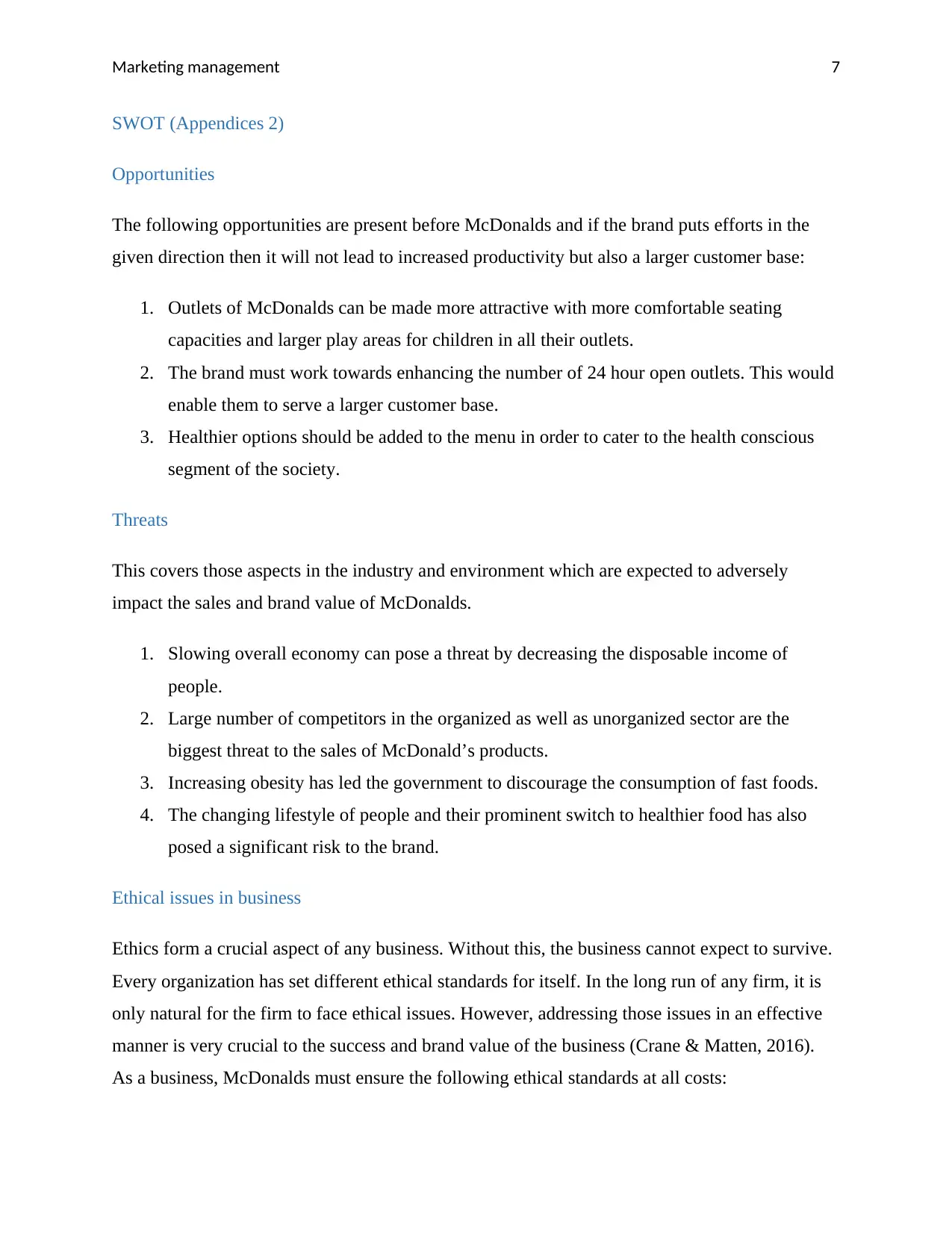
Marketing management 7
SWOT (Appendices 2)
Opportunities
The following opportunities are present before McDonalds and if the brand puts efforts in the
given direction then it will not lead to increased productivity but also a larger customer base:
1. Outlets of McDonalds can be made more attractive with more comfortable seating
capacities and larger play areas for children in all their outlets.
2. The brand must work towards enhancing the number of 24 hour open outlets. This would
enable them to serve a larger customer base.
3. Healthier options should be added to the menu in order to cater to the health conscious
segment of the society.
Threats
This covers those aspects in the industry and environment which are expected to adversely
impact the sales and brand value of McDonalds.
1. Slowing overall economy can pose a threat by decreasing the disposable income of
people.
2. Large number of competitors in the organized as well as unorganized sector are the
biggest threat to the sales of McDonald’s products.
3. Increasing obesity has led the government to discourage the consumption of fast foods.
4. The changing lifestyle of people and their prominent switch to healthier food has also
posed a significant risk to the brand.
Ethical issues in business
Ethics form a crucial aspect of any business. Without this, the business cannot expect to survive.
Every organization has set different ethical standards for itself. In the long run of any firm, it is
only natural for the firm to face ethical issues. However, addressing those issues in an effective
manner is very crucial to the success and brand value of the business (Crane & Matten, 2016).
As a business, McDonalds must ensure the following ethical standards at all costs:
SWOT (Appendices 2)
Opportunities
The following opportunities are present before McDonalds and if the brand puts efforts in the
given direction then it will not lead to increased productivity but also a larger customer base:
1. Outlets of McDonalds can be made more attractive with more comfortable seating
capacities and larger play areas for children in all their outlets.
2. The brand must work towards enhancing the number of 24 hour open outlets. This would
enable them to serve a larger customer base.
3. Healthier options should be added to the menu in order to cater to the health conscious
segment of the society.
Threats
This covers those aspects in the industry and environment which are expected to adversely
impact the sales and brand value of McDonalds.
1. Slowing overall economy can pose a threat by decreasing the disposable income of
people.
2. Large number of competitors in the organized as well as unorganized sector are the
biggest threat to the sales of McDonald’s products.
3. Increasing obesity has led the government to discourage the consumption of fast foods.
4. The changing lifestyle of people and their prominent switch to healthier food has also
posed a significant risk to the brand.
Ethical issues in business
Ethics form a crucial aspect of any business. Without this, the business cannot expect to survive.
Every organization has set different ethical standards for itself. In the long run of any firm, it is
only natural for the firm to face ethical issues. However, addressing those issues in an effective
manner is very crucial to the success and brand value of the business (Crane & Matten, 2016).
As a business, McDonalds must ensure the following ethical standards at all costs:
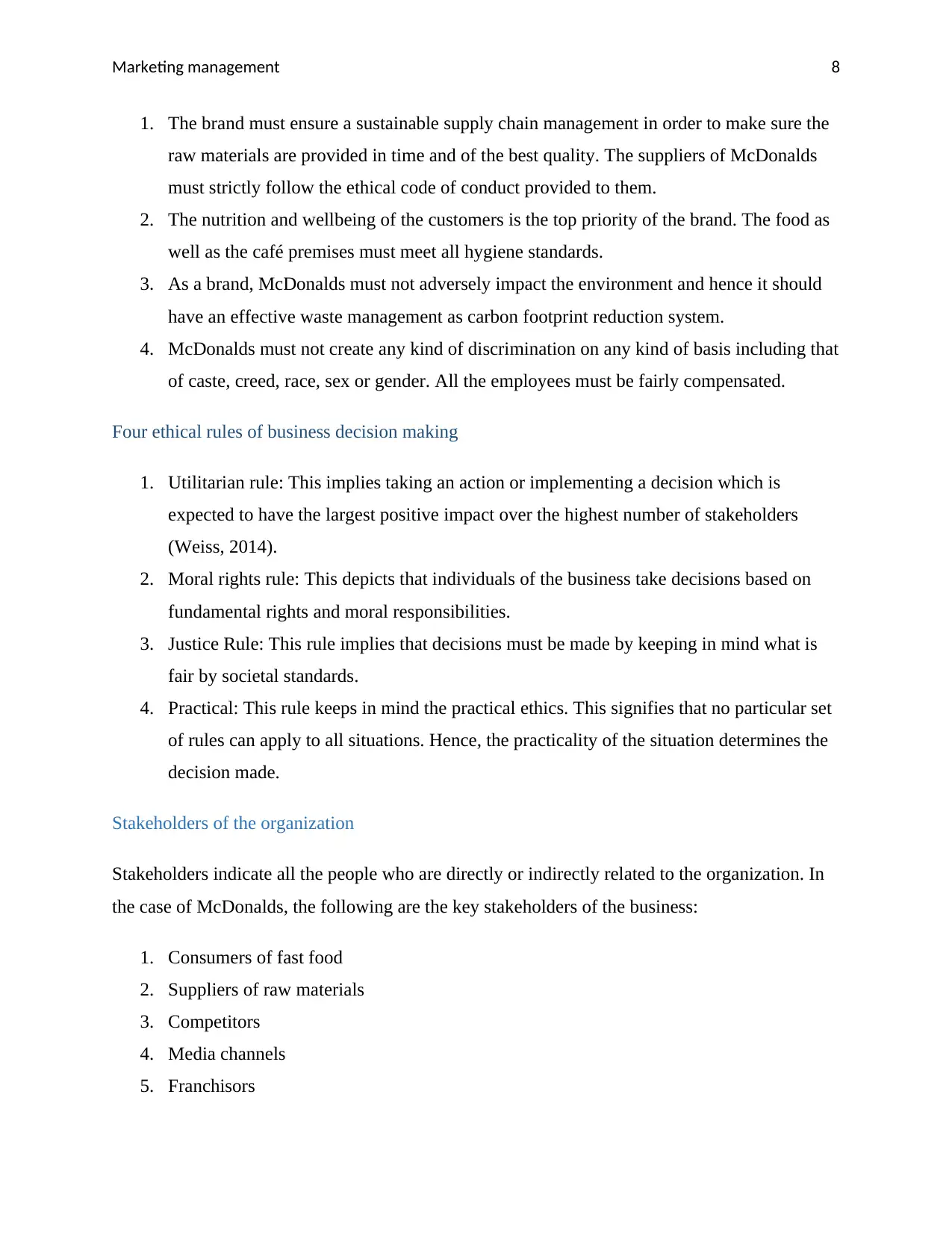
Marketing management 8
1. The brand must ensure a sustainable supply chain management in order to make sure the
raw materials are provided in time and of the best quality. The suppliers of McDonalds
must strictly follow the ethical code of conduct provided to them.
2. The nutrition and wellbeing of the customers is the top priority of the brand. The food as
well as the café premises must meet all hygiene standards.
3. As a brand, McDonalds must not adversely impact the environment and hence it should
have an effective waste management as carbon footprint reduction system.
4. McDonalds must not create any kind of discrimination on any kind of basis including that
of caste, creed, race, sex or gender. All the employees must be fairly compensated.
Four ethical rules of business decision making
1. Utilitarian rule: This implies taking an action or implementing a decision which is
expected to have the largest positive impact over the highest number of stakeholders
(Weiss, 2014).
2. Moral rights rule: This depicts that individuals of the business take decisions based on
fundamental rights and moral responsibilities.
3. Justice Rule: This rule implies that decisions must be made by keeping in mind what is
fair by societal standards.
4. Practical: This rule keeps in mind the practical ethics. This signifies that no particular set
of rules can apply to all situations. Hence, the practicality of the situation determines the
decision made.
Stakeholders of the organization
Stakeholders indicate all the people who are directly or indirectly related to the organization. In
the case of McDonalds, the following are the key stakeholders of the business:
1. Consumers of fast food
2. Suppliers of raw materials
3. Competitors
4. Media channels
5. Franchisors
1. The brand must ensure a sustainable supply chain management in order to make sure the
raw materials are provided in time and of the best quality. The suppliers of McDonalds
must strictly follow the ethical code of conduct provided to them.
2. The nutrition and wellbeing of the customers is the top priority of the brand. The food as
well as the café premises must meet all hygiene standards.
3. As a brand, McDonalds must not adversely impact the environment and hence it should
have an effective waste management as carbon footprint reduction system.
4. McDonalds must not create any kind of discrimination on any kind of basis including that
of caste, creed, race, sex or gender. All the employees must be fairly compensated.
Four ethical rules of business decision making
1. Utilitarian rule: This implies taking an action or implementing a decision which is
expected to have the largest positive impact over the highest number of stakeholders
(Weiss, 2014).
2. Moral rights rule: This depicts that individuals of the business take decisions based on
fundamental rights and moral responsibilities.
3. Justice Rule: This rule implies that decisions must be made by keeping in mind what is
fair by societal standards.
4. Practical: This rule keeps in mind the practical ethics. This signifies that no particular set
of rules can apply to all situations. Hence, the practicality of the situation determines the
decision made.
Stakeholders of the organization
Stakeholders indicate all the people who are directly or indirectly related to the organization. In
the case of McDonalds, the following are the key stakeholders of the business:
1. Consumers of fast food
2. Suppliers of raw materials
3. Competitors
4. Media channels
5. Franchisors
⊘ This is a preview!⊘
Do you want full access?
Subscribe today to unlock all pages.

Trusted by 1+ million students worldwide
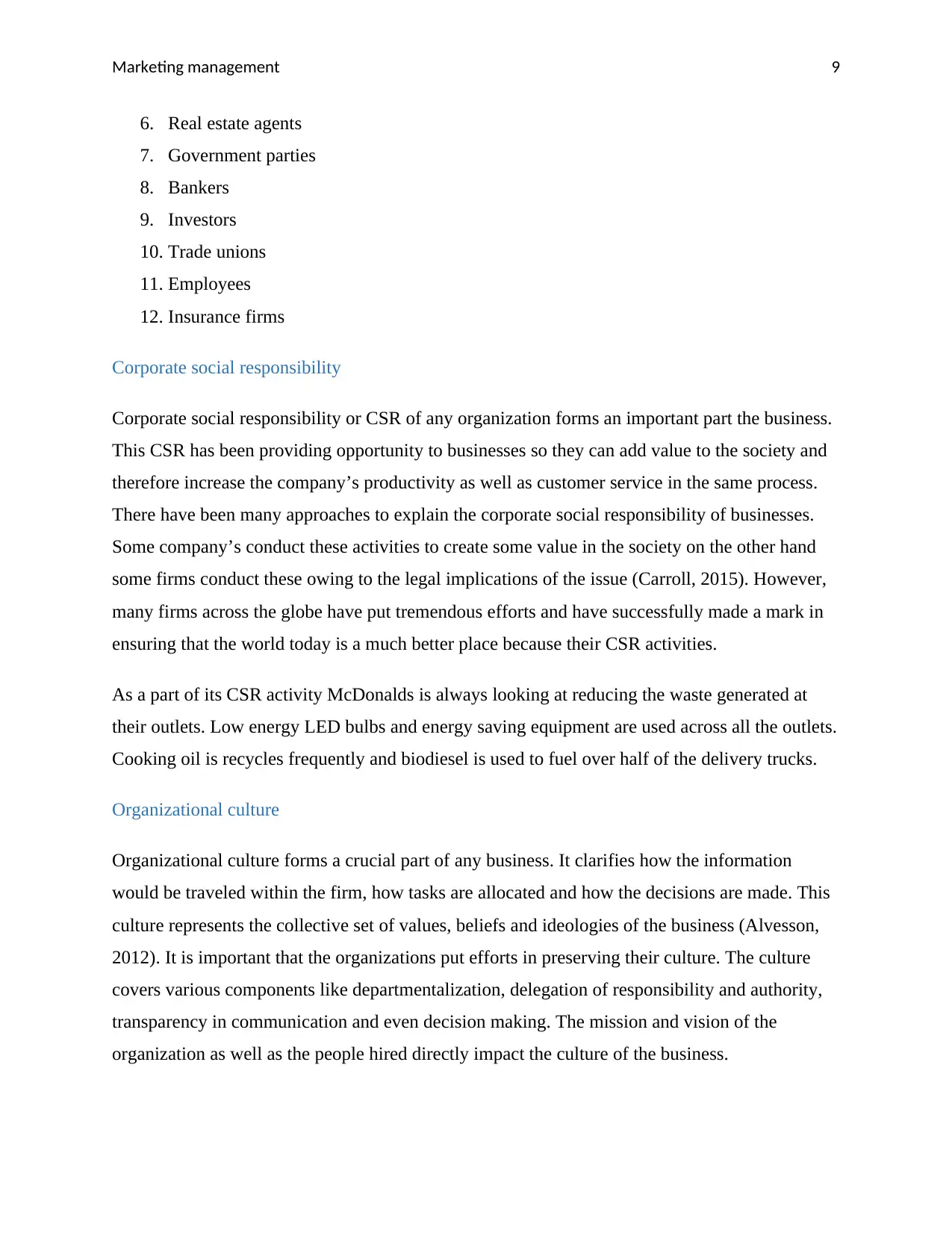
Marketing management 9
6. Real estate agents
7. Government parties
8. Bankers
9. Investors
10. Trade unions
11. Employees
12. Insurance firms
Corporate social responsibility
Corporate social responsibility or CSR of any organization forms an important part the business.
This CSR has been providing opportunity to businesses so they can add value to the society and
therefore increase the company’s productivity as well as customer service in the same process.
There have been many approaches to explain the corporate social responsibility of businesses.
Some company’s conduct these activities to create some value in the society on the other hand
some firms conduct these owing to the legal implications of the issue (Carroll, 2015). However,
many firms across the globe have put tremendous efforts and have successfully made a mark in
ensuring that the world today is a much better place because their CSR activities.
As a part of its CSR activity McDonalds is always looking at reducing the waste generated at
their outlets. Low energy LED bulbs and energy saving equipment are used across all the outlets.
Cooking oil is recycles frequently and biodiesel is used to fuel over half of the delivery trucks.
Organizational culture
Organizational culture forms a crucial part of any business. It clarifies how the information
would be traveled within the firm, how tasks are allocated and how the decisions are made. This
culture represents the collective set of values, beliefs and ideologies of the business (Alvesson,
2012). It is important that the organizations put efforts in preserving their culture. The culture
covers various components like departmentalization, delegation of responsibility and authority,
transparency in communication and even decision making. The mission and vision of the
organization as well as the people hired directly impact the culture of the business.
6. Real estate agents
7. Government parties
8. Bankers
9. Investors
10. Trade unions
11. Employees
12. Insurance firms
Corporate social responsibility
Corporate social responsibility or CSR of any organization forms an important part the business.
This CSR has been providing opportunity to businesses so they can add value to the society and
therefore increase the company’s productivity as well as customer service in the same process.
There have been many approaches to explain the corporate social responsibility of businesses.
Some company’s conduct these activities to create some value in the society on the other hand
some firms conduct these owing to the legal implications of the issue (Carroll, 2015). However,
many firms across the globe have put tremendous efforts and have successfully made a mark in
ensuring that the world today is a much better place because their CSR activities.
As a part of its CSR activity McDonalds is always looking at reducing the waste generated at
their outlets. Low energy LED bulbs and energy saving equipment are used across all the outlets.
Cooking oil is recycles frequently and biodiesel is used to fuel over half of the delivery trucks.
Organizational culture
Organizational culture forms a crucial part of any business. It clarifies how the information
would be traveled within the firm, how tasks are allocated and how the decisions are made. This
culture represents the collective set of values, beliefs and ideologies of the business (Alvesson,
2012). It is important that the organizations put efforts in preserving their culture. The culture
covers various components like departmentalization, delegation of responsibility and authority,
transparency in communication and even decision making. The mission and vision of the
organization as well as the people hired directly impact the culture of the business.
Paraphrase This Document
Need a fresh take? Get an instant paraphrase of this document with our AI Paraphraser
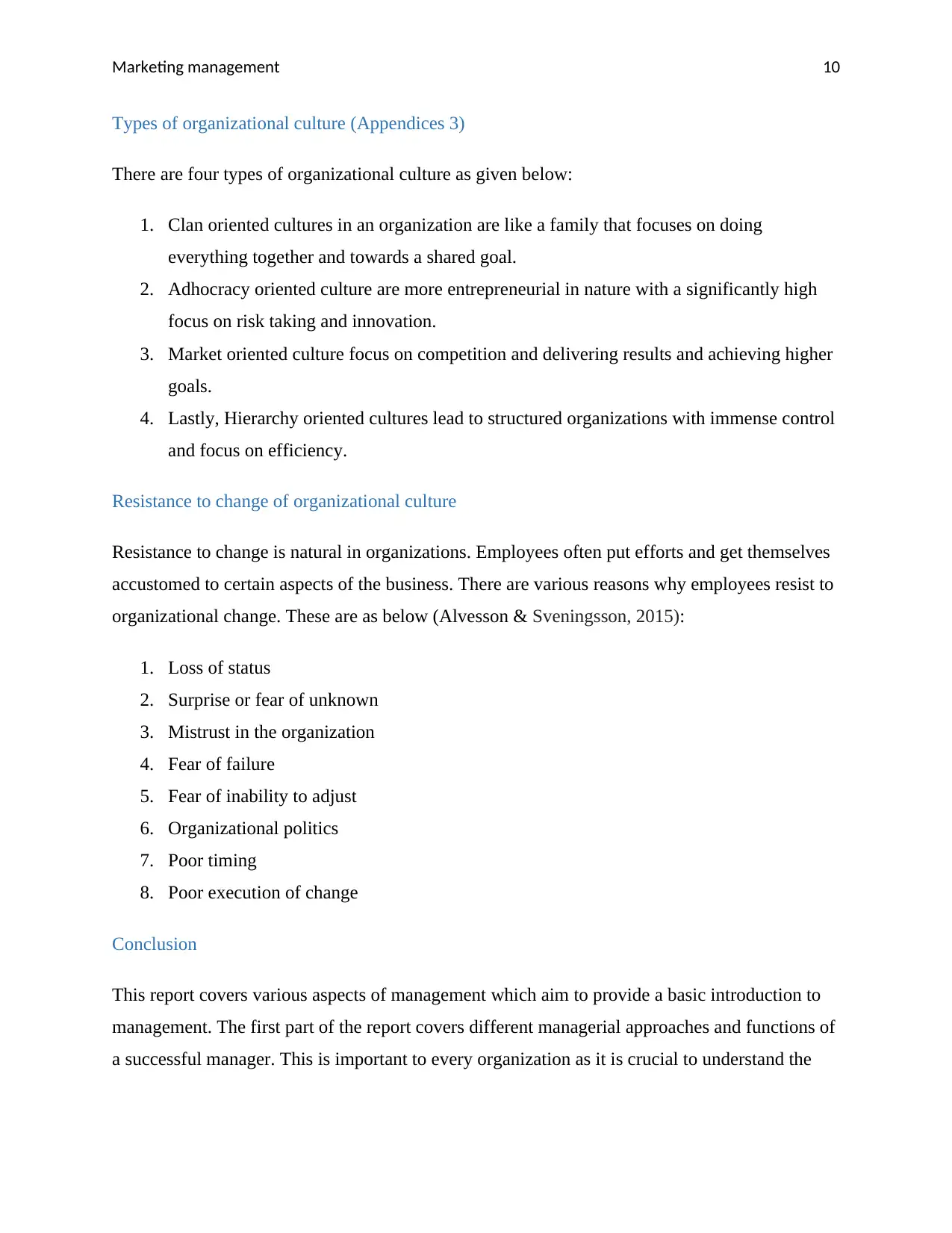
Marketing management 10
Types of organizational culture (Appendices 3)
There are four types of organizational culture as given below:
1. Clan oriented cultures in an organization are like a family that focuses on doing
everything together and towards a shared goal.
2. Adhocracy oriented culture are more entrepreneurial in nature with a significantly high
focus on risk taking and innovation.
3. Market oriented culture focus on competition and delivering results and achieving higher
goals.
4. Lastly, Hierarchy oriented cultures lead to structured organizations with immense control
and focus on efficiency.
Resistance to change of organizational culture
Resistance to change is natural in organizations. Employees often put efforts and get themselves
accustomed to certain aspects of the business. There are various reasons why employees resist to
organizational change. These are as below (Alvesson & Sveningsson, 2015):
1. Loss of status
2. Surprise or fear of unknown
3. Mistrust in the organization
4. Fear of failure
5. Fear of inability to adjust
6. Organizational politics
7. Poor timing
8. Poor execution of change
Conclusion
This report covers various aspects of management which aim to provide a basic introduction to
management. The first part of the report covers different managerial approaches and functions of
a successful manager. This is important to every organization as it is crucial to understand the
Types of organizational culture (Appendices 3)
There are four types of organizational culture as given below:
1. Clan oriented cultures in an organization are like a family that focuses on doing
everything together and towards a shared goal.
2. Adhocracy oriented culture are more entrepreneurial in nature with a significantly high
focus on risk taking and innovation.
3. Market oriented culture focus on competition and delivering results and achieving higher
goals.
4. Lastly, Hierarchy oriented cultures lead to structured organizations with immense control
and focus on efficiency.
Resistance to change of organizational culture
Resistance to change is natural in organizations. Employees often put efforts and get themselves
accustomed to certain aspects of the business. There are various reasons why employees resist to
organizational change. These are as below (Alvesson & Sveningsson, 2015):
1. Loss of status
2. Surprise or fear of unknown
3. Mistrust in the organization
4. Fear of failure
5. Fear of inability to adjust
6. Organizational politics
7. Poor timing
8. Poor execution of change
Conclusion
This report covers various aspects of management which aim to provide a basic introduction to
management. The first part of the report covers different managerial approaches and functions of
a successful manager. This is important to every organization as it is crucial to understand the
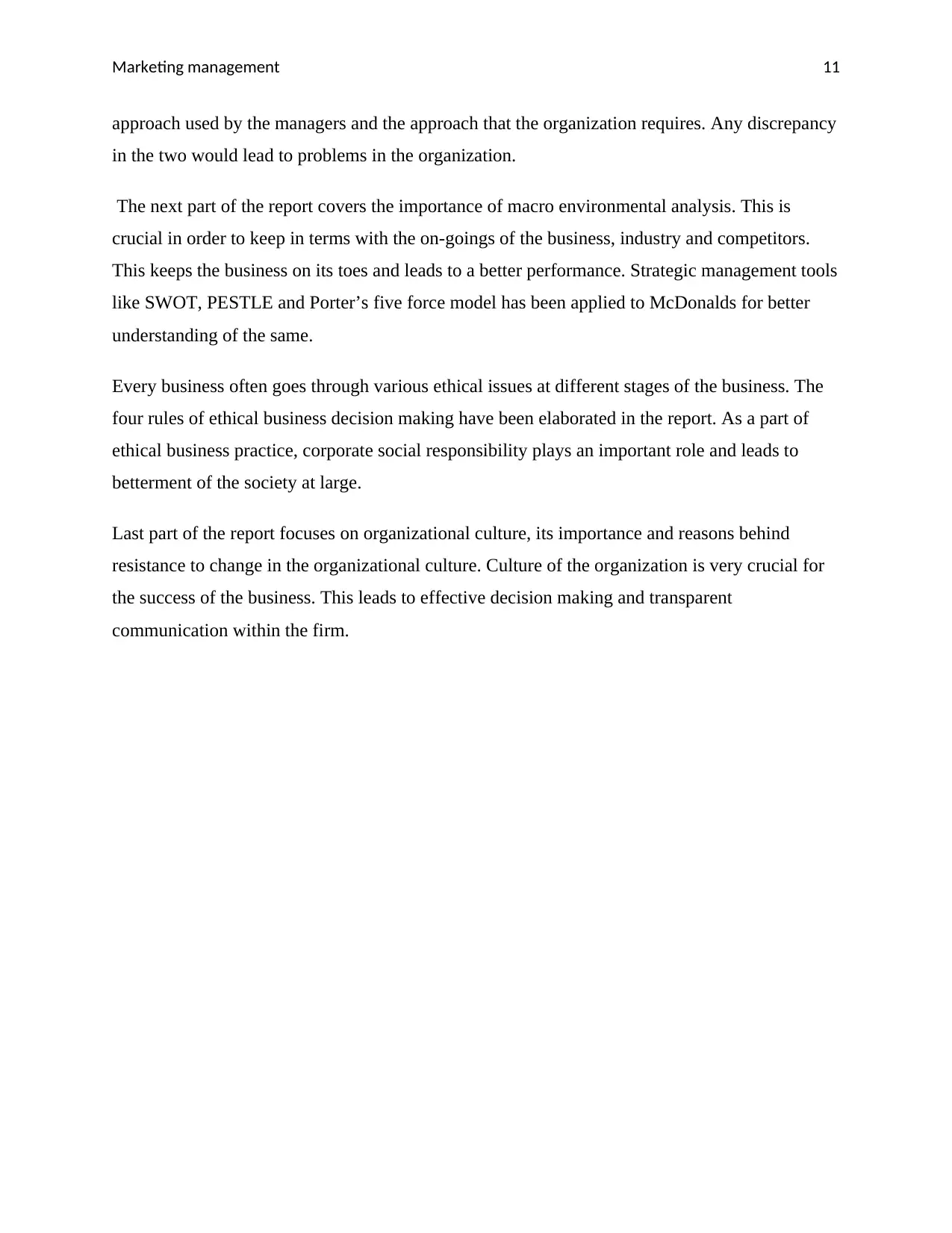
Marketing management 11
approach used by the managers and the approach that the organization requires. Any discrepancy
in the two would lead to problems in the organization.
The next part of the report covers the importance of macro environmental analysis. This is
crucial in order to keep in terms with the on-goings of the business, industry and competitors.
This keeps the business on its toes and leads to a better performance. Strategic management tools
like SWOT, PESTLE and Porter’s five force model has been applied to McDonalds for better
understanding of the same.
Every business often goes through various ethical issues at different stages of the business. The
four rules of ethical business decision making have been elaborated in the report. As a part of
ethical business practice, corporate social responsibility plays an important role and leads to
betterment of the society at large.
Last part of the report focuses on organizational culture, its importance and reasons behind
resistance to change in the organizational culture. Culture of the organization is very crucial for
the success of the business. This leads to effective decision making and transparent
communication within the firm.
approach used by the managers and the approach that the organization requires. Any discrepancy
in the two would lead to problems in the organization.
The next part of the report covers the importance of macro environmental analysis. This is
crucial in order to keep in terms with the on-goings of the business, industry and competitors.
This keeps the business on its toes and leads to a better performance. Strategic management tools
like SWOT, PESTLE and Porter’s five force model has been applied to McDonalds for better
understanding of the same.
Every business often goes through various ethical issues at different stages of the business. The
four rules of ethical business decision making have been elaborated in the report. As a part of
ethical business practice, corporate social responsibility plays an important role and leads to
betterment of the society at large.
Last part of the report focuses on organizational culture, its importance and reasons behind
resistance to change in the organizational culture. Culture of the organization is very crucial for
the success of the business. This leads to effective decision making and transparent
communication within the firm.
⊘ This is a preview!⊘
Do you want full access?
Subscribe today to unlock all pages.

Trusted by 1+ million students worldwide
1 out of 16
Related Documents
Your All-in-One AI-Powered Toolkit for Academic Success.
+13062052269
info@desklib.com
Available 24*7 on WhatsApp / Email
![[object Object]](/_next/static/media/star-bottom.7253800d.svg)
Unlock your academic potential
Copyright © 2020–2025 A2Z Services. All Rights Reserved. Developed and managed by ZUCOL.



